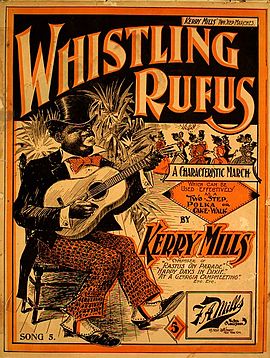Annotation:Whistling Rufus
Back to Whistling Rufus
WHISTLING RUFUS. AKA and see "Way Down South in Dixie." Old Time. Bluegrass; Two-Step, March, Reel, Polka. USA; Virginia, West Virginia, Alabama, Missouri, Arkansas, Arizona. G Major {Beisswenger & McCann, Phillips}: G Major ('A' and 'B' parts) & C Major ('C' part). Standard tuning (fiddle). AB (Beisswenger & McCann, Phillips): AAB (Brody). The tune was composed in 1899 by Kerry Mills [1] (1869-1948, who also composed “Georgia Camp Meeting” and “Red Wing”), at the beginning of the ragtime era. It was described at the time of its publication as a “characteristic march” but with the addition that it “can be used effectively as a two-step, polka or cakewalk.” The first page of the original music also records that:

No cakewalk given in the Black Belt district of Alabama was considered worth while attending unless “Whistling Rufus” was engaged to furnish the music. Unlike other musicians, Rufus always performed alone, playing an accompaniment to his whistling on an old guitar, and it was with great pride that he called himself the “one-man band.”
Cauthen (1990), however, calls it a minstrel composition that passed into fiddling tradition, although on what authority she suggests the predating of Mills is not known. Arizona fiddler Kenner C. Kartchner identified it as a "good two step from around 1900" (Shumway). It was played by Rock Ridge, Alabama, fiddlers around 1920 and it appears in a list of traditional Ozarks Mountains fiddle tunes compiled by musicologist/folklorist Vance Randolph, published in 1954. It is also played as a fast breakdown by bluegrass musicians. Stacy Phillips (1995) notes that the first section is sometimes bowed right next to the bridge, resulting in a whistle-like tone. The tune was in the repertoire of West Virginia fiddler Edden Hammons. It was recorded on a cylinder record in 1899 by Vess L. Ossman, the pre-eminent banjo player of the 1890’s, nicknamed “The Banjo King.” Early 78 RPM recordings include Gid Tanner & Riley Puckett (1924), Ernest Thompson (1924), McLaughlin’s Old Time Melody Makers (1928), the Kessinger Brothers (1929) and Arkie the Arkansas Woodchopper (1941) [see Guthrie Meade,Country Music Sources, 2002]. See also related melodies “Old Parnell Reel” and “North Carolina Breakdown.”
“Whistling Rufus” was popularized in Scotland and Ireland by Scottish accordion player and dance-band leader Jimmy Shand, who recorded it in the 1950’s.
Source for notated version: Buddy Pendleton [Brody]; Gary Johnston (b. 1937, Nevada, Missouri), learned from Lyman Enloe in the 1960’s [Beisswenger & McCann].
Printed sources: Beisswenger & McCann (Ozarks Fiddle Music), 2008; p. 81. Brody (Fiddler’s Fakebook), 1983; p. 291. Phillips (Traditional American Fiddle Tunes, vol. 2), 1995; p. 166. Ruth (Pioneer Western Folk Tunes), 1948; No. 40, p. 15.
Recorded sources: American Heritage 510, Jay Belt "Fiddlin' Jay Belt." Bluebird Records, 1934, The Skillet Lickers. County 705, Buddy Pendleton "Virginia Breakdown." County 412, "Fiddling Doc Roberts" (Ky.) {appears as "Way Down South"}.
E. Berliner's Gramophone – 092, Vess Ossman (1899). Folkways FA 2337, Clark Kessiger (Va.) "Live at Union Grove." Marimac 9017, Vesta Johnson (Mo.) "Down Home Rag." Rebel 1531, Curly Ray Cline "Fishin' For Another Hit." Edden Hammons Collection, Disc 2. “Doc Watson & Son” (1965).
See also listing at:
Jane Keefer’s Folk Music Index: An Index to Recorded Sources []
Alan Snyder's Cape Breton Fiddle Recordings Index [2]
See various versions on youtube.com: bluegrass [3]; ragtime [4]; march/polka [5]
Hear Fiddlin' Arthur Smith's version at Slippery Hill [6]
